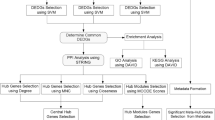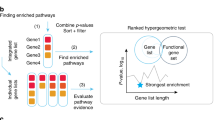Abstract
Hepatocellular carcinoma (HCC) is one of the major causes of cancer deaths worldwide. New diagnostic and therapeutic options are needed for more effective and early detection and treatment of this malignancy. We identified 703 genes that are highly expressed in HCC using DNA microarrays and further characterized them in order to uncover novel tumor markers, oncogenes and therapeutic targets for HCC. Using Gene Ontology annotations, genes with functions related to cell proliferation and cell cycle, chromatin, repair and transcription were found to be significantly enriched in this list of highly expressed genes. We also identified a set of genes that encode secreted (e.g. GPC3, LCN2 and DKK1) or membrane-bound proteins (e.g. GPC3, IGSF1 and PSK-1), which may be attractive candidates for the diagnosis of HCC. A significant enrichment of genes highly expressed in HCC was found on chromosomes 1q, 6p, 8q and 20q and we also identified chromosomal clusters of genes highly expressed in HCC. The microarray analyses were validated by RT–PCR and PCR. This approach of integrating other biological information with gene expression in the analysis helps select aberrantly expressed genes in HCC that may be further studied for their diagnostic or therapeutic utility.
This is a preview of subscription content, access via your institution
Access options
Subscribe to this journal
Receive 50 print issues and online access
$259.00 per year
only $5.18 per issue
Buy this article
- Purchase on Springer Link
- Instant access to full article PDF
Prices may be subject to local taxes which are calculated during checkout





Similar content being viewed by others
References
Bohen SP, Troyanskaya OG, Alter O, Warnke R, Botstein D, Brown PO and Levy R . (2003). Proc. Natl. Acad. Sci. USA, 100, 1926–1930.
Boyle EI, Weng S, Gollub J, Jin H, Botstein D, Cherry JM and Sherlock G . (2004). Bioinformatics, 20, 3710–3715.
Capurro M, Wanless IR, Sherman M, Deboer G, Shi W, Miyoshi E and Filmus J . (2003). Gastroenterology, 125, 89–97.
Chen X, Cheung ST, So S, Fan ST, Barry C, Higgins J, Lai KM, Ji J, Dudoit S, Ng IO, Van De Rijn M, Botstein D and Brown PO . (2002). Mol. Biol. Cell, 13, 1929–1939.
Chen X, Higgins J, Cheung ST, Li R, Mason V, Montgomery K, Fan ST, Rijn Mv M and So S . (2004). Mod. Pathol., 17, 1198–1210.
Cheung ST, Chen X, Guan XY, Wong SY, Tai LS, Ng IO, So S and Fan ST . (2002). Cancer Res., 62, 4711–4721.
Crawley JJ and Furge KA . (2003). Genome Biol., 3 research 0075.1-0075.8.
Eisen MB, Spellman PT, Brown PO and Botstein D . (1998). Proc. Natl. Acad. Sci. USA, 95, 14863–14868.
El-Serag H . (2001). Clin. Liver Dis., 5, 87–107.
El-Serag HB . (2002). J. Clin. Gastroenterol., 35, S72–S78.
Feitelson MA, Sun B, Satiroglu Tufan NL, Liu J, Pan J and Lian Z . (2002). Oncogene, 21, 2593–2604.
Gollin SM . (2004). Curr. Opin. Oncol., 16, 25–31.
Helton WS, Di Bisceglie A, Chari R, Schwartz M and Bruix J . (2003). J. Gastrointest. Surg., 7, 401–411.
Hippo Y, Watanabe K, Watanabe A, Midorikawa Y, Yamamoto S, Ihara S, Tokita S, Iwanari H, Ito Y, Nakano K, Nezu J, Tsunoda H, Yoshino T, Ohizumi I, Tsuchiya M, Ohnishi S, Makuuchi M, Hamakubo T, Kodama T and Aburatani H . (2004). Cancer Res., 64, 2418–2423.
Iyer VR, Eisen MB, Ross DT, Schuler G, Moore T, Lee JC, Trent JM, Staudt LM, Hudson Jr J, Boguski MS, Lashkari D, Shalon D, Botstein D and Brown PO . (1999). Science, 283, 83–87.
Jallepalli PV and Lengauer C . (2001). Nat. Rev. Cancer, 1, 109–117.
Lee JS, Chu IS, Heo J, Calvisi DF, Sun Z, Roskams T, Durnez A, Demetris AJ and Thorgeirsson SS . (2004). Hepatology, 40, 667–676.
Lee JS and Thorgeirsson SS . (2002). Hepatology, 35, 1134–1143.
Lin TY, Lee CS, Chen KM and Chen CC . (1987). Br. J. Surg., 74, 839–842.
Mor E, Kaspa RT, Sheiner P and Schwartz M . (1998). Ann. Intern. Med., 129, 643–653.
Neo SY, Leow CK, Vega VB, Long PM, Islam AF, Lai PB, Liu ET and Ren EC . (2004). Hepatology, 39, 944–953.
Nguyen MH and Keeffe EB . (2002). J. Clin. Gastroenterol., 35, S86–S91.
Nielsen TO, West RB, Linn SC, Alter O, Knowling MA, O’Connell JX, Zhu S, Fero M, Sherlock G, Pollack JR, Brown PO, Botstein D and van de Rijn M . (2002). Lancet, 359, 1301–1307.
Nishida N, Nishimura T, Ito T, Komeda T, Fukuda Y and Nakao K . (2003). Histol. Histopathol., 18, 897–909.
Okabe H, Satoh S, Kato T, Kitahara O, Yanagawa R, Yamaoka Y, Tsunoda T, Furukawa Y and Nakamura Y . (2001). Cancer Res., 61, 2129–2137.
Pan K-H, Lih C-J and Cohen SN . (2002). Proc. Natl. Acad. Sci. USA, 99, 2118–2123.
Parkin DM . (2001). Lancet Oncol., 2, 533–543.
Parkin DM, Bray F, Ferlay J and Pisani P . (2001). Int. J. Cancer, 94, 153–156.
Pinkel D, Segraves R, Sudar D, Clark S, Poole I, Kowbel D, Collins C, Kuo WL, Chen C, Zhai Y, Dairkee SH, Ljung BM, Gray JW and Albertson DG . (1998). Nat. Genet., 20, 207–211.
Pollack JR, Perou CM, Alizadeh AA, Eisen MB, Pergamenschikov A, Williams CF, Jeffrey SS, Botstein D and Brown PO . (1999). Nat. Genet., 23, 41–46.
Shirota Y, Kaneko S, Honda M, Kawai HF and Kobayashi K . (2001). Hepatology, 33, 832–840.
Smith MW, Yue ZN, Geiss GK, Sadovnikova NY, Carter VS, Boix L, Lazaro CA, Rosenberg GB, Bumgarner RE, Fausto N, Bruix J and Katze MG . (2003). Cancer Res., 63, 859–864.
Tusher VG, Tibshirani R and Chu G . (2001). Proc. Natl. Acad. Sci. USA, 98, 5116–5121.
Whitfield ML, Sherlock G, Saldanha AJ, Murray JI, Ball CA, Alexander KE, Matese JC, Perou CM, Hurt MM, Brown PO and Botstein D . (2002). Mol. Biol. Cell, 13, 1977–2000.
Ye QH, Qin LX, Forgues M, He P, Kim JW, Peng AC, Simon R, Li Y, Robles AI, Chen Y, Ma ZC, Wu ZQ, Ye SL, Liu YK, Tang ZY and Wang XW . (2003). Nat. Med., 9, 416–423.
Zhang H, Pan KH and Cohen SN . (2003). Proc. Natl. Acad. Sci. USA, 100, 3251–3256.
Acknowledgements
We are grateful to Stanford Functional Genomic Center and Stanford Microarray database for their support. This work is supported by a grant to the Asian Liver Center at Stanford University by the HM Lui Foundation (to M-SC, RL and SS), the UCSF Liver Center (DK26743-22) pilot/feasibility project award and NCI K01 award (to XC) and grants from the National Foundation for Cancer Research and the Defense Advanced Projects Research Agency (DARPA) (to SNC). K-H Pan is supported by a Stanford Graduate Fellowship.
Author information
Authors and Affiliations
Electronic supplementary material
Rights and permissions
About this article
Cite this article
Patil, M., Chua, MS., Pan, KH. et al. An integrated data analysis approach to characterize genes highly expressed in hepatocellular carcinoma. Oncogene 24, 3737–3747 (2005). https://doi.org/10.1038/sj.onc.1208479
Received:
Revised:
Accepted:
Published:
Issue Date:
DOI: https://doi.org/10.1038/sj.onc.1208479
Keywords
This article is cited by
-
A targetable LIFR−NF-κB−LCN2 axis controls liver tumorigenesis and vulnerability to ferroptosis
Nature Communications (2021)
-
May Neutrophil Gelatinase-Associated Lipocalin (NGAL) Level Predict Mortality in Patients with Hepatocellular Carcinoma (HCC)?
Journal of Gastrointestinal Cancer (2020)
-
δ-Tocotrienol feeding modulates gene expression of EIF2, mTOR, protein ubiquitination through multiple-signaling pathways in chronic hepatitis C patients
Lipids in Health and Disease (2018)
-
Paracrine and autocrine regulation of gene expression by Wnt-inhibitor Dickkopf in wild-type and mutant hepatocytes
BMC Systems Biology (2017)
-
Copy number gain of granulin-epithelin precursor (GEP) at chromosome 17q21 associates with overexpression in human liver cancer
BMC Cancer (2015)



